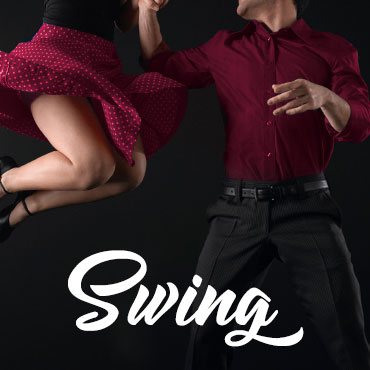The History Behind the Swing
The Lindy (Swing) picked up for the Charleston left off. It had “swing outs”, “breakaways” and “shine steps”. With the birth of Swing music in the mid 1930’s the Lindy climbed the social ladder. In August 1935, at the Palomar Ballroom, bandleader Benny Goodman played a Fletcher Henderson arrangement of Stomping at the Savoy”. The rest, as they say, is history. The dance craze swept the nation, and depending on where you live, it was the Jitterbug, the Lindy Hop or the Swing. Since those days, each successive generation has “discovered” the fun of Swing. This most uniquely American dance is enjoyed all of the world.
Swing Music
Swing, Jitterbug, Jive, Shag, Lindy Hop, etc. are normally written in 2/4 or 4/4 time with the musical accents occurring on the second or second and fourth beats of a measure. Swing includes two general rhythms: Swing Rhythm – 1, 2, 3 & 4, 5 & 6 or it’s equivalent; Lindy Rhythm – 1, 2, 3 & 4, 5, 6, 7 & 8 or it’s equivalent; Swing may be danced comfortably over a wide range of tempos.
Characteristics of Swing
A sidestep or a triple step (shuffle) followed by rock step down to lively music is the fundamental pattern for this dance. Perhaps the most uniquely American of all dances, the Swing brings forth a buoyant carefree movement. It’s one of the dances that becomes contagious.
Teaching Elements & Basics of Swing
- Basics – Turns and position changes
- Open Breaks – Fingertip lead and follow; arm control
- Footwork – Weight changes in rotation
- Maneuverability – Learn how to move comfortably in all directions
- Swing motion & accents – Stress the use of beats to steps and body to music
- Various timings – Single, double and triple timing as well as Lindy timing to adjust to different music tempos
- Compare? Contrast – Lindy Hop, West Coast Swing, Foxtrot
What Are You Waiting For?
Start Dancing Today!
Swing songs and artists include:
- In the Mood – Glenn Miller
- Rock Around the Clock – Bill Haley and the Comets
- Start Me Up – The Rolling Stones
- Jump Jive and Wail – Louis Prima or The Brian Setzer Orchestra


